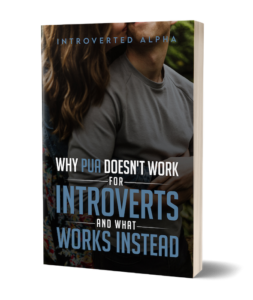What is Enneagram disintegration?
The Enneagram is a fantastic tool for understanding yourself and others. I wrote an intro post on it here, and in this post I’ll dive into overthinking and how to resolve that by learning more about the Enneagram disintegration and integration paths. You can discover much more about this here.
Why is overthinking even an issue?
Self-actualization is a psychological growth process and can therefore come with more than a little bit of overthinking.
Overthinking to one degree or another is a normal part of being human. This is especially the case when you’re focused on your own growth:
- “Did I say the wrong thing?” (then getting quiet and self-conscious)
- “Did I just permanently screw up all chances with this person?” (further retreating)
- “What will happen if I mess up?” (psyching self out and then not trying)
While these are normal human thoughts, they are also unnecessary to have in bulk and intensity. If your ultimate goal is a better, more authentic and fulfilling life, this is especially the case.
You have so many rich opportunities available to you. You can self-actualize in an upward spiral, to conquer your fears and be a true hero.
Flow State
You have it in you to just be.
As you access your natural flow state, then “being you” becomes enough, and THAT is why overthinking is unnecessary.
Overthinking is taking you in the OPPOSITE direction of achieving a flow state because flow state is not something you can achieve in the way you achieve other things.
If all the other things you’ve done are like fights in a video game, living in flow state is the boss fight.
In all the previous “fights” (conquests, accomplishments), you could win in fairly predictable and consistent ways.
But in the “boss fight,” all those things stop working, and you keep “dying”. A whole new approach is required to win the ultimate boss fight.
That whole new approach begins with this thought:
What if the root of overthinking is not knowing who you are?
By “knowing who you are”, I mean both (a) accepting your raw capability and (b) understanding the “code” for surpassing your uniquely personal egoic fears.
As I mentioned with the fights versus boss fights, your “code” for living in flow state is often in the opposite direction of what you would think, since (1) your fears mess with your reasoning abilities and (2) you can’t know what you don’t know.
And again, knowing that overthinking, or any type of suffering, is technically “unnecessary” is the first step to shifting into your flow state, and yet that alone doesn’t just erase it.
Acknowledging that overthinking (and all that brings on) is unnecessary suffering isn’t the magic eraser.
Finding the Root
It simply invites you to find it, to find the root of the psychological suffering (and its consequences) which is always DEEP within yourself.
The root of psychological suffering is so deep. And it’s liberating to find the root of it because understanding yourself leads to more self-compassion and self-respect.
Deeper and more liberating than exploring many of the options available to you that just dance around the central issue but don’t land inside it, don’t find a home in it.
Here is the home/root of overthinking, which is tied to MUCH suffering, especially for the introverted man:
Not knowing who you are.
Reason being, by coming to know who you are on the deepest level, you liberate yourself from the hamster wheel of overthinking.
You equip yourself with the clarity, fortitude, and direction to step off the hamster wheel and into your flow state (which, let’s call it an infinity pool or an always-safe-landing continual waterfall… much nicer than a hamster wheel!).
The best, most effective way to enter this “infinity pool” is to understand yourself through the lens of Enneagram disintegration and integration.
What is the Enneagram, again?
You can refer to my intro to the Enneagram to get an overview of what this amazing system is and how to start finding yourself within it.
(Also, the website The Enneagram Institute by Riso and Hudson, authors of The Wisdom of The Enneagram and other great books, is an authority on the system.)
Once you find yourself within the personality types of the Enneagram, there is no end to how much you can learn about the Enneagram disintegration and integration.
As you apply what you learn to your life, you will always learn more about yourself and make strides in your personal growth as your life unfolds.
The act of living while reflecting on your nature, your patterns, and your potential in this way is very exciting and enlightening.
Building on what I wrote in my introduction to the Enneagram, I’ll now walk you through how to apply Enneagram disintegration and integration to yourself if you sometimes feel withdrawn or if you struggle with keeping a strong sense of self-esteem around others. You can discover much more about this here.
Understanding is Liberating
Once I explain Enneagram disintegration and integration to you, you will see *why* you feel that way, which is so encouraging!
Understanding yourself naturally leads to compassion for yourself, which empowers you and puts you in a stronger place with your self-development.
This is especially wonderful because it redeems our younger, child selves and what we wanted back then…
As children, we naturally assumed that once we were grown up, we would be autonomous, self-supportive, and confident.
The thing is, once we are actually adults, that sense of self-security can feel elusive.
We can feel quite shy and withdrawn, even though we know we are fully capable adults. That’s where Enneagram disintegration and integration comes in.
Why is that?
Why do we sometimes feel “held back” to our younger selves, to that very young, shy self… anxiously trying to find a spot in the lunchroom, now in the lounge bar; or feeling pushed around by the class bully, now by a domineering colleague?
The answer is in our distinct individual types and patterns of Enneagram disintegration and integration.
This is one of the most helpful and fascinating aspects of the Enneagram that we’re exploring this week.
As you may remember by now, there are nine types, and each has a particular direction of integration (what other type it looks like when it becomes secure), and a specific direction of disintegration (what other type it looks like as it becomes stressed or insecure).
In this blog post, we’re focusing on the direction of disintegration and how to move into integration for a few specific types.
Let’s apply the direction of Enneagram disintegration specifically to you guys.
Chances are that if you feel shy and go away from the world when you’re stressed, then either your main type or your direction of Enneagram disintegration type is a Withdrawn type.
(You can refresh yourself on all nine types in my blog post introducing the Enneagram.)
This is very helpful to know about yourself. Reason being, when you see your stress response objectively, then in the moment when you are starting to feel stressed, you know where things are headed. You can even know how to turn them around before they become a big production!
Let’s look at what the Withdrawn types are. Then we’ll discuss how to work through each, getting back up into your secure and healthy state.
Obviously, there is a lot more I have to say on all of this than what can reasonably fit inside a blog post. Still, you will learn a lot just here in this one teaching!
Which are the Withdrawn types?
First, for context, the non-Withdrawn types are as follows:
- Earning types are Type One, Type Two, and Type Six.
- Demanding types are Type Three, Type Seven, and Type Eight.
The Withdrawn types are Type Four (Individualist), Type Five (Investigator), and Type Nine (Peacemaker).
Also, some types disintegrate to the Withdrawn types in the 9 Levels of Development.
You might be one of these as your main type. Or you might be a type that disintegrates to one of these:
- Type 8 (Challenger) disintegrates to Type 5.
- Type 1 (Reformer) disintegrates to Type 4.
- And Type 3 (Achiever) disintegrates to Type 9.
Whether you are a Withdrawn type or whether your type (either the Eight, One, or Three) disintegrates into a Withdrawn type, there are patterns you’ll see in yourself as you become stressed:
//
Type 4
If you are or disintegrate to Type 4, then you may find yourself withdrawing from the world in order to understand your feelings better.
Reason being, a common tendency of Type 4’s is to over-identify with feelings, thinking that they *are* the feelings they’re having. So they need time to sort out their feelings before they feel free to act.
/
Type 5
If you are or disintegrate to Type 5, then you might find yourself withdrawing from the world in order to sort your thoughts, to understand the world in a logical and complete way.
Reason being, for a Type 5, it doesn’t feel safe to act or be closely involved in the world until things are understood from an objective, comprehensive vantage point.
/
Type 9
If you are or disintegrate to Type 9, then you may find yourself withdrawing from the world in order to not be fundamentally impacted by unpleasant things.
Reason being, a Type 9 wants peace. So sometimes the strategy is to go away from situations or facts that are not seemingly peaceful in order to maintain autonomous peacefulness, even if shaky due to ignoring facts.
What can you learn from this?
It is so helpful to understand your default point of view at various points along the Enneagram disintegration <> integration scale, from unhealthy levels to average levels to healthy levels.
Having a bit of distance to see yourself more clearly improves not only your intimate relationships but your own relationship with yourself.
Here is what it shows you about how to move from Enneagram disintegration into integration as a Withdrawn type:
//
Type 4
If you are or disintegrate to Type 4, then it’s helpful to remember that you are not your feelings. You are so much more than your feelings; if anything, you are your inspiration.
When you are inspired is when you are most like your true, full self. And inspiration is separate from feeling, completely distinct.
So inspire yourself with action towards what is important to you. Then you will feel yourself come alive and feel deeply connected to yourself.
/
Type 5
If you are or disintegrate to Type 5, then it’s helpful to remember that you will always be learning and growing your knowledge through visceral, real-world experience.
Also, you already know more than most people do, simply because of how very thoughtful you are. Therefore, you are not fundamentally unprepared for life at all.
So you don’t need to wait on the sidelines to sort your thoughts; rather, you can go on ahead and test your theories in the real world, refining as you go.
/
Type 9
If you are or disintegrate to Type 9, then it’s helpful to remember that your response to stress is not limited to withdrawal; instead as a Type 9, you have the ability to assert yourself in a beautiful, strong way.
Assertion and aggression are not the same. And as a Type 9, you have a special ability to be gently and gracefully assertive.
As you stay connected to your naturally balanced and serene core, you can take small steps towards asserting yourself in the world. Soon, you will find a more deeply rooted peace than withdrawal can ever provide.
Learning from Enneagram disintegration…
As with all self-reflection, the idea is not to add judgment on ourselves (unnecessary and uncalled for!). The idea is to understand ourselves better. This way, we can live more fully and self-actualize further in all areas of our lives.
This is the map of the human situation and the uniquely human opportunity to self-actualize:
Every single type has its full beautiful expression at liberation, as well as its potential to disintegrate into neurosis. Enneagram disintegration and integration together represent the full range of options available to us as human beings…
And there are endless kaleidoscopic options available the more we become liberated and self-actualized.
Reason being, at that point so much life is flowing through us. So we have many ways to express ourselves!
As we do that, a new sense of self-respect emerges. Naturally, overthinking quiets down because we no longer need it in the same way.
For more on this topic , visit this introduction to the Enneagram.










